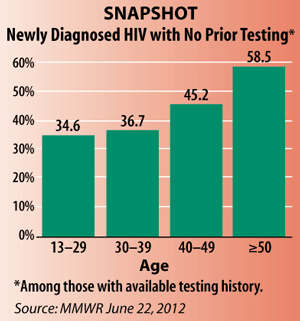Routine HIV Testing Still Lacking in High-Risk Groups
Among those for whom testing history was available, just over 40% of adults and adolescents newly diagnosed with human immunodeficiency virus (HIV) had not been tested for HIV previously, according to new research by the Centers for Disease Control and Prevention (CDC). In contrast, nearly 60% had a negative HIV test at some point prior to the HIV diagnosis. Those least likely to have been tested in the past included adults older than age 50, African Americans, and individuals whose HIV transmission was attributed to heterosexual sex or injection drug use. The findings underscore the need to boost efforts to increase routine HIV testing in high-risk populations, thereby reducing the time between HIV infection and diagnosis.
CDC's study, Previous HIV Testing Among Adults and Adolescents Newly Diagnosed with HIV Infection, looked at HIV testing patterns between 2006–2009 in 18 jurisdictions participating in the agency’s National HIV Surveillance System. Together, these 16 states and the cities of Chicago and Philadelphia accounted for 60% of reported acquired immune deficiency syndrome cases during the same period.

In 2006, CDC recommended at least annual HIV testing in individuals at high-risk for infection, under the premise that knowing one's HIV status might reduce behaviors that transmit the virus, and connect those who are HIV positive with care, thereby improving their health outcomes.
Overall, the study found that 125,104 individuals had a positive HIV test; prior testing information was available for nearly 46%. Prior testing history was more likely to be available for those age 29 or younger and individuals whose HIV transmission was attributed to male-to-male sexual activity.
Of the 57,476 for whom prior testing history was available, nearly one-quarter had a negative HIV test result within 1 year of HIV diagnosis. Another 12% had a negative test result 13–24 months prior to the positive test, and 21% had a negative result more than 2 years before.